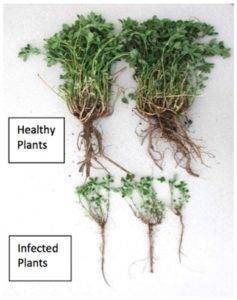
The world of soils is made up of a complex living biology. Uncovering production-limiting factors can be one of the many links to selecting the best products and seed treatments for that acre. More specifically, it is helpful to know the most prominent diseases that could hamper emergence and yield. There are steps you can take to reduce that risk.
Aphanomyces Root Rot is a big word to describe a microscopic pathogen with the power to cause big problems. The fungus responsible, Aphanomyces euteiches, is an oomycete that is present in many Midwest soils. It’s especially prevalent in heavy, wet, poorly drained soils. The pathogen spreads by zoospores, which move easily in wet soils. Many years ago, scientists discovered two dominant races of this particular pathogen: Race 1 and Race 2. The latter proves more virulent or infectious. There is speculation of a “Race 3” although testing is still taking place.
Aphanomyces often presents as stunted, yellow plants with poor root development and very few lateral roots. If the seedling becomes infected, symptoms escalate to include yellow cotyledons and first leaves with chlorosis. The roots and stems will first appear grey (often water soaked) and then change to brown. Yield reduction results from poor root growth and significantly less nodules.

Rebound is also extremely slow after harvest. If you are concerned you have Aphanomyces and want to know which races you have, you can submit a soil sample to the UW Plant Disease and Diagnostic Clinic.
Plant breeders rose to the challenge and have done a great job selecting varieties of alfalfa with high resistance to Race 1. When Race 2 was discovered, they also began selecting for that. On page 69 of the 2021 Latham® product guide, you will find our disease resistance chart with Aphanomyces Race 1 and 2 index ratings.
In addition to genetic resistance, we also equip our alfalfa varieties with an additional layer of protection with AlfaShield seed treatment. The success of a multi-year alfalfa stand rests on good emergence and seedling survival. Latham Hi‑Tech Seeds includes Stamina® in its seed treatment to provide that needed broad-spectrum protection against soil-borne pathogens.
Seed treatments that don’t include Stamina can suffer mortality rates of up to 75% in the seedling year. Discount seed companies tend to use older plant genetics and cheaper seed treatments, which can offer significantly less protection. In addition to high mortality rates, the risk includes reduced stands and less yield.
Latham Seeds can we reduce that risk, increase your yield potential and promote greater stand longevity thanks to good genetic resistance and seed treatments. Talk with your Latham rep to learn more. Now is a great time to buy alfalfa for spring seeding!
